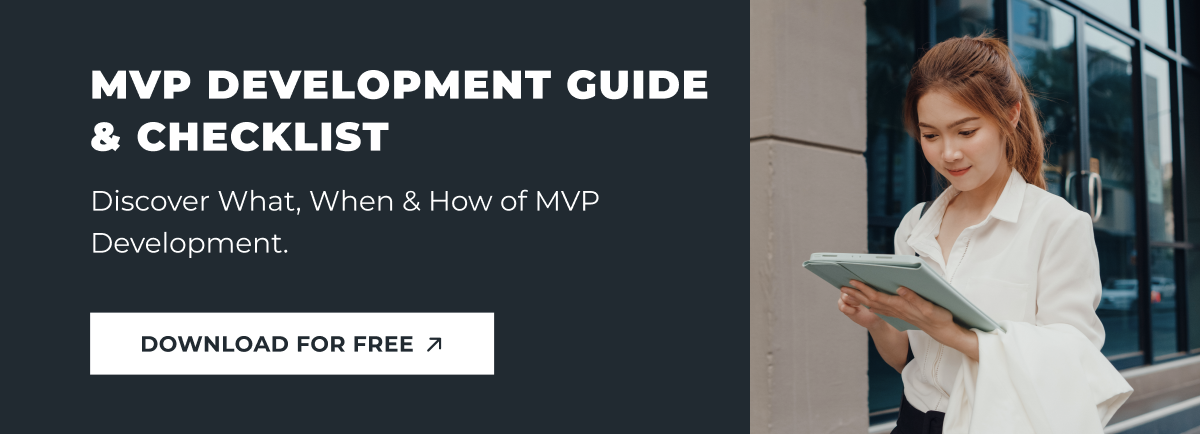Looking to build an MVP for your startup? Already read a few guides and want a trusted, practical second opinion? Or are you just getting started and need a clear place to begin? What exactly is an MVP, and why does it matter?
If any of that sounds like you, this guide will answer those questions and more. You’ll learn what an MVP is and why it’s essential for startups. We’ll also walk you through a step-by-step process, from validating your idea and designing key features to gathering feedback, iterating, and estimating costs.
By the end, you’ll understand how to turn your idea into a working version that real users want and that you can confidently present to investors.
Why this matters: Many startups fail simply because people don’t actually need what they’re building. Creating an MVP helps you avoid that mistake. It allows you to test your idea early, learn what works and what doesn’t, and make improvements before investing too much time or money.
As a product development company, we’ve helped startups design and ship MVPs for over 7 years. This guide distills that hands-on experience into a practical playbook you can follow.
Key takeaways
- Validate before you build. An MVP helps confirm real demand before you invest heavily in development.
- Solve one core problem. Focus on what matters most to your users, not every possible feature.
- Listen early and often. Real user feedback is the fastest way to improve and avoid costly mistakes.
- Keep it simple but solid. Even a minimal product should feel functional and reliable.
- Iterate continuously. Small, data-driven updates turn an MVP into a product users love.
What Is an MVP?
An MVP, or a minimum viable product, is a seed point of your product. It’s a beta version of your software that has a minimum number of vital features that allow you to answer 3 main questions:
- Is there a need for your product?
- Does it solve the problem?
- Is it monetizable?
The term “minimum viable product” itself was coined in 2001. Back then, Frank Robinson, CEO at SyncDev, and entrepreneurs Steve Blank and Eric Ries worked on Customer Development and Validation and came up with such a term. MVP is the best description of a potential product that checks how the market reacts to the solution.
The MVP is considered an experiment in the context of validating business hypotheses. It lets entrepreneurs know whether a business idea would be viable and profitable by testing the assumptions. It is beneficial for new companies and startups to find out where potential business opportunities exist rather than executing an isolated business model.
The best description of an MVP is probably the words of Michael Seibel, Y Combinator CEO
"Hold the problem you're solving tightly, hold the customer tightly, hold the solution you're building loosely."
MVP’s purpose
As you cannot build a house without laying the foundation, you can't create a successful product without building an MVP. The purpose of an MVP is to start with a small use case, test it and then decide: whether you need to pivot and move in another direction or develop the idea into a product solution.

MVP standards
There's an opinion that MVP product development is about making a raw product in haste. In fact, at the MVP stage, your product should already work, check the key hypotheses, and include essential features only. At the same time, it must be built in a short time, no longer than 3 months.
So, the standard is high, especially if you have a startup and want to pitch your idea to investors. It's not enough to create a black&white app with a poor interface. You have to stand out and be a step ahead of your competitors.

Benefits of building an MVP
You'd be surprised how many founders' journeys end before a single user has actually held their product in their hands. It's a common situation, which is why going through the MVP development process is so important for success. Here’s what other benefits you gain:

- Get the attention of investors. Instead of just explaining your idea, you can show it through an MVP. When investors see that people are using and enjoying your product, they’re far more likely to support and fund your project.
- Build a product people actually use. Many founders have a fixed idea of their product, but staying flexible is key. An MVP helps you stay open to feedback so you can focus on what users truly need and drop what doesn’t serve them.
- Understand your market better. Creating an MVP encourages you to dig deeper into your users’ problems and your competitors’ solutions. This process often reveals new opportunities and market gaps you might have missed if you’d built the full product right away.
- Test your idea quickly and affordably. MVP development focuses only on essential features. That means you spend less time and money while still validating your idea. You can test real user reactions before committing to a full-scale build.
- Experiment with low risk. An MVP gives you room to grow and adapt. You can easily add extra features, test new technologies, and pivot based on feedback. Overall, it keeps your product flexible for future changes.
What should we align on before building?
Before you start creating an MVP, it’s important to get your team on the same page about a few key points. This early step, sometimes referred to as a preflight kickoff, helps you establish clear goals and expectations.
With those in place, your team can stay focused and make better decisions when testing the product. This approach also reduces unnecessary back-and-forth and keeps development running smoothly.
Define constraints, first-sales approach, and research plan
The first thing you need to do is identify your main constraints: time, budget, and team resources. Setting clear limits helps you focus on what’s realistic and prioritize what matters most.
Next, decide on your first sales approach. Will you target pilot users, early adopters, or offer pre-orders?
With your approach in mind, create a research plan that outlines how you’ll study your target audience, test your assumptions, and gather meaningful insights. By aligning on these points early, you give your team a strong foundation and avoid unnecessary rework as you build.
Create proto-personas and initial customer journey hypotheses
Next, figure out who your early users are. You don’t need detailed personas yet. Just simple profiles that show your potential customers and their biggest challenges. Then, map out a rough customer journey to see how people might discover, try, and use your product.
Keep in mind that these are only early hypotheses; in Step 2 of the next section, you’ll validate and refine them with real user data. These early ideas will help you focus on the features that matter most and test how real users behave later.
Define validation metrics & decision thresholds
Once you understand your early users and their journey, the next step is to decide how you’ll measure success. Choose a few key metrics, such as sign-ups, engagement, or retention, that indicate whether your MVP is solving the problem.
Set clear benchmarks so you know when to move forward, make changes, or stop altogether. This approach ensures every next step is guided by real data rather than assumptions.
How Do You Build an MVP Step by Step?
MVP product development doesn't differ significantly from software product development in general. The steps are more or less the same, but the speed and goals vary. An MVP is created with the intent to enter the market fast, test key hypotheses, attract early adopters, and achieve product-market fit from early on.
Below, we'll guide you through all these stages of the minimum viable product creation process in more detail so that you can be prepared for the pitfalls.
Step 1: Define a problem statement
First things first, MVP development starts with identifying the problem. As you know the problem, you can come up with a solution. Sounds logical, but things aren't that easy.
You can identify the problem in many ways.
You're a domain expert. Let's say you're working in the real estate industry and know it inside out. And you also know that some landlords can't sell houses fast because the pictures of their properties aren't attractive enough. That would be a potential problem that you can solve.
You're not satisfied with the existing solutions. "Progress cannot be generated when we are satisfied with existing situations." This is a quote from Taiichi Ohno, a Japanese industrial engineer, businessman, and the father of Toyota. And this describes the power of dissatisfaction, criticism, and healthy skepticism towards things. So, question and challenge things around you because a potential niche can be close.
You were told that there's a problem. This one is tricky because you need to find proof of these words. On the one hand, a person telling you this can be an expert on the topic. On the other hand, it can be a person who's facing a problem. No matter who, you need to check and ensure that the problem really exists, it's big enough, and people are looking for the solution.
The takeaway is that validating the idea without development is crucial. It saves resources and ensures that there's a need in your MVP.
Step 2: Conduct market research
Once you define the real problem, it's time to analyze the market. A survey conducted by CB Insights found that the top reason why startups fail was a 'lack of market need.' In simple words, if the product doesn't nail the problem, customers won't use it to find a solution.
MVP development for startups demands research. So what do you need to do?
- Explore competitors. Analyze their features, pricing, and market gaps to understand what works and what doesn’t.
- Identify your target audience. Refine the proto-personas and customer journey hypotheses from your preflight kickoff to get a clearer picture of who you’re designing for.
- Calculate the market size. Make sure there are enough potential customers willing to pay for your solution.
Running out of money is the second reason why young startups fail. You should know for sure that people want to pay money for your product, and their number is high enough to start it all.
Step 3: Prototype potential solution
You might ask: Why do I need both a prototype and a software MVP? A prototype is an early attempt to visualize a working solution, while an MVP is a bare form of the product that performs target actions.
A prototype puts the design and functionalities into perspective, validates UI & UX, and lets you get early feedback for improvements that you'll then implement in an MVP. Good examples of prototypes are:
- Sketches
- Wireframes
- Paper prototypes
Literally, everything demonstrates how the product will be built.
Steve Jobs avoided the stage of prototyping while building the Apple Lisa. As a result, the product was a catastrophe and unprofitable.
Step 4: Define features list
Okay, with a defined problem, robust research, and feedback on your prototype, you start prioritizing all the features of your minimum viable product. And when we say “prioritizing,” we really mean it: You should only add core functionality to an MVP to prevent feature creep. The latter happens when a product receives too many features, which makes it too complicated and confusing.
Prioritizing MVP features may cause difficulties. Among the number of prioritization frameworks, story mapping is our favorite in the case of startup MVP features. You can also use other methods:
- MoSCoW: classify features as Must-have, Should-have, Could-have, or Won’t-have.
- ICE: score features based on Impact, Confidence, and Ease.
- Impact–Effort: weigh features by the value they bring versus the effort they require.
How does it work? You created a horizontal axis for the user journey and a vertical axis for priority. Then you place features on the map. As a result, you'll have various features sorted according to the usage sequence and importance.
Story mapping is great for charting out an MVP and maintaining an ever-growing list of features. Features that are higher up in priority obviously deserve more attention than others.
Step 5: Validate your project
Wondering if your idea is worth building? Before writing a single line of code, you can test whether your concept actually resonates with potential users. This optional step allows you to validate demand and refine your approach without committing to full development.
Here are some effective ways to do it:
- Landing Page MVP — Build a simple web page that clearly explains your product idea, its key benefits, and how it solves a problem. Add a call to action such as “Join the waitlist” or “Get early access.” Tracking sign-ups, click-throughs, or time on page helps gauge genuine interest.
- Concierge MVP — Personally deliver the service or solution to a few early users, handling everything manually. This helps you deeply understand customer needs and refine your process before investing in automation or scaling. (for example, scheduling tutoring sessions manually before building a booking app.)
- Wizard-of-Oz MVP — Unlike a Concierge MVP, users believe the product is already automated and fully functional, while you secretly perform the backend work yourself. This approach tests whether users value the experience without revealing that it’s powered by humans behind the scenes. Think of it as a “fake it until you make it” approach.
- Early sign-ups (Pre-orders) — Take validation a step further by allowing users to pay or pre-register for your product before it’s live. If enough people commit financially or reserve their spot, it’s a strong signal that users see real value in what you’re offering.
- Demo videos and other non-code artifacts — Create a short product video, interactive prototype, or clickable mockup that shows how your product would work. This is one of the fastest ways to visualize your idea, attract early adopters, and collect feedback before development. For instance, Dropbox’s original MVP was just a simple explainer video demonstrating how file syncing would work and it generated thousands of sign-ups overnight.
The key idea here is that you don’t need a finished product to prove demand. Results-first validation helps you test assumptions early, avoid costly mistakes, and focus your efforts on building something people actually want.

Step 6: Develop your MVP
With the list of features agreed upon, you can move to the key phase — MVP development. At this stage, focus on building only the core feature first. This approach ensures you don’t overload your product or your team with unnecessary functionality and allows you to focus on what’s most valuable to users.
Additionally, it’s important to find the right middle ground and achieve a balance between keeping your MVP professional and crisp. During the development, keep your eye on the bug-free and high-quality nature of your MVP. This polished initial version allows users to fully appreciate the core value of your product, laying a strong foundation for its continued development and enhancement.
Another thing to keep in mind at this stage is that there are different types of MVPs. So the development scope and time will greatly depend on the MVP type you plan for. You’ll find more information about this in the next section.
Step 6: Get user feedback and work with It
To prevent the feature creep issue from happening, it is also crucial to collect feedback from users at the stage of MVP product development.
You can go with the traditional ways, such as conducting user interviews and surveys to understand the target audience's needs in terms of functionality.
For example, when working on the Nomad case — a real estate app for buying and renting homes — we at Uptech followed these approaches during the discovery phase of the project. Our team conducted extensive user interviews, similar to the strategies mentioned, to get a complete picture of the functionality needs of our target audience. Owing to this, we managed to tailor the Nomad app's features to precisely meet user expectations, showcasing the effectiveness of directly engaging with users to shape MVP development.

If traditional approaches don’t fit, you can add more innovative options, such as feedback software tools like FeedBear that aggregate feedback from various sources.
The critical point here is that the faster you start gathering user feedback, the better. Relying on the customers' responses, you make a final list of the vital features that will be added to your MVP and a roadmap based on it.
Monitor post-launch KPIs
Once your MVP is live, start paying attention to how people are actually using it. You’ll quickly see what’s working and what’s kind of missing the mark. Here are a few key metrics to keep an eye on after your MVP goes live:
- ARPU (Average Revenue Per User): How much revenue each user generates on average.
- CLV (Customer Lifetime Value): The total value a customer contributes over their entire relationship with your product.
- Churn: The percentage of users who stop using your product.
Keeping track of these numbers gives you a clear picture of what’s working and what needs to be fixed.
Step 7: Iterate constantly
Before updating your product, make sure you have the right feedback systems and roadmap tools in place. These will help you gather user insights, track progress, and plan your next steps without losing focus.
With an MVP in your hands, you should iterate again and again based on the user's reaction. Continue to collect responses and test the changes, as it's the only way to figure out how to build something that people need and love. The goal here is to make a minimum viable product software with basic features only to test the product-market fit and get significant results.
Mind that the research stage shouldn't end when the MVP development starts. It should go in parallel.
Different Types of MVPs
Now that you know the necessary steps to build an MVP app, let’s deal with another aspect of the topic — the different types of MVPs that exist. You have read that correctly; MVPs come in various formats that serve different business needs. Understanding these types will help you decide which one fits your situation better.
In most cases, you can divide all minimum viable products into two major categories: low-fidelity and high-fidelity MVPs.
- Low-fidelity MVPs are early product versions that have the purpose of validating the core idea without full-scale development. Examples include a pre-order MVP and a landing page.
- High-fidelity MVPs, in contrast, are more functional and closer to the final product, offering a detailed and interactive experience. Some popular examples are a concierge MVP, a Wizard of Oz MVP, and a single-feature MVP.
Landing Page MVP
As the name suggests, you make a landing page that speaks up about what's good about your product and lets people either buy it now or sign up to be told when it's ready. The cool part is you get to collect emails, so you can chat directly with potential customers, figure out if people really want what you're selling, and see how they behave on your page to improve the product.
Let’s take Uptech’s design concept of a banking web app for example. The design has everything needed for a landing page: It explains the product’s idea and provides all the functionality for signing up for a service.

By the way, Airbnb MVP looked like a simply designed landing page. Its main goal was to check if people would book the apartment. And that was pretty enough to see that, yes, people actually did it.
Pre-Order MVP
The pre-order MVP is a crowdfunding approach when you sell your product before actually building it. It's great for projects that need much money to start and want customers to commit early. Think of it like when people pay in advance for a video game that's not out yet. This helps the people making the product to see if there's enough interest and get some money to help make it.
Here’s an example of a pre-order MVP. People can buy a new version of the GTA video game — GTA VI — before its release. The price tag is insane, though.

Single-Feature MVP
This type of high-fidelity MVP focuses on developing only one core functionality of your product idea to see how users react to it.
If you take a look at Uber's MVP version with one core feature and the full-fledged one, you notice the difference right away. The MVP did one thing, it connected cab drivers with iPhone owners in San Francisco and let them pay for the ride with a credit card. It was enough to see if people were ready for a totally new taxi experience.

Plai, our internal product for people and performance management, is another great example of how implementing only one core feature in your MVP can help succeed.

We undertook 20+ interviews with target users to identify their key pain points and problems. We then conducted a Design Sprint to prototype and tested the application rapidly. Finally, based on this info, we created the MVP with the OKR feature.
When should you move beyond an MVP to MLP or MMP — and how?
Once your MVP has proven your idea works and gained some early users, it’s time to think about the next stage: turning your product into an MLP (Minimum Lovable Product) or an MMP (Minimum Marketable Product). But how do you know when and how to make this move?
What is an MMP?
A Minimum Marketable Product (MMP) is the first version of your product that people are actually willing to pay for.
- Goal: Move from testing your idea to making money.
- Focus: Include enough features, polish, and stability to deliver real value.
- Why: To check if people are willing to pay and start building a business model.
- Key Points:
- Looks more complete than an MVP.
- It may not have all the advanced features, but it feels like a proper product.
- Ready for a small but real customer base.
- Example: Slack’s early version didn’t have all the integrations it has now, but it was solid enough for teams to start using and paying for it.
What is an MLP?
A Minimum Lovable Product (MLP) goes beyond basic functionality. It’s not just something people can use — it’s something they enjoy and love.
- Goal: Make users not only use your product but also really like it.
- Focus: User experience, emotional connection, and trust.
- Why: In competitive markets, just being usable isn’t enough.
- Key Points:
- Valuable: Solves a problem well, even with minimal features.
- User-focused: Built around real user needs and feedback.
- Delightful: Designed to be enjoyable, not just useful.
- Builds loyalty: Encourages users to stick around and tell others.
- Stands out: Feels different from other options.
- Example: Instagram in 2010 had only three features: photo uploads, filters, and a feed. But smooth performance, simple design, and fun filters made people love it — and it quickly became popular.
Which stage should your product reach next?
- To MLP: When your MVP has proven that people like your product, and you want to make it more engaging and fun.
- To MMP: When you’re ready to sell your product to a wider audience and need it to be stable and polished enough for real customers.
Think of it as a journey:
- MVP = Experiment — test your idea and see if it works.
- MMP = Product — sell the idea and prove people are willing to pay.
- MLP = Experience — make users love your product and win their loyalty.
More MVP examples to start a digital business can be found in our dedicated article.
How Much Does MVP Development Cost?
Let’s get straight to it. The average cost of MVP development typically ranges from $30K to $60K, but can reach up to $100,000 for more complex products. Of course, the final cost depends on your project’s scope, design, and technical requirements.
If you’re only testing an early proof of concept (POC), a simpler version used to validate a core idea, the cost usually falls between $5k and $10k. However, building a functional MVP with real user flows and essential features requires a larger investment.
The work needed to create a Twitter-like MVP will differ significantly from building an Uber-style platform. That’s why it makes more sense to discuss pricing by feature set or development stage rather than giving one-size-fits-all figures. Since every project has unique needs, we’ve broken down the typical costs by stage below to give you a clearer idea.
When considering the cost, it’s useful to look at it from different angles:
- Project Complexity: The more features and advanced functions your MVP has, the higher the cost.
- Basic MVPs with minimal functionality: $5K–$10K
- Moderate MVPs with additional features (profile management, API integrations): $12K–$25K
- Complex MVPs with advanced functionality, UI/UX, AI, and multi-platform support: $30K+
- Development Stage: Market research, prototyping, and MVP development each have their own time and cost (as shown in the table).
- Team Size and Structure: Bigger or more specialized teams cost more, while smaller teams or freelancers are cheaper but may take longer.
- Freelancers: $20–$150/hr (cheaper but riskier due to commitment/communication issues)
- MVP Development Company: $25–$130/hr (recommended for most startups)
- In-House Team: $75–$200/hr (expensive but offers full control)
- Platform Choice: Building for one platform costs less than developing for multiple platforms or using cross-platform tools.
- Single Platform (iOS, Android, Web): $10K–$125K
- Multiplatform (native apps for each platform): $25K–$150K
- Cross-Platform (React Native, Flutter, etc.): $30K–$160K
- Technology Stack: The tech you choose affects speed, flexibility, and overall budget.
- Standard Tech (HTML, PHP): $8K–$14K
- Modern Tech (Node.js, React, etc.): $10K–$20K
- Emerging Tech (AI, IoT): $20K+
- Development Approach: The way you develop your MVP affects how much it costs and how long it takes.
- Agile Methodology: $13K–$140K
- Waterfall Model: $20K–$175K
- Low-Code/No-Code Solutions: $2.5K–$8K
- Level of Customization: When you give your product a unique design or style, you’ll probably spend a bit more.
- Basic: $4K–$10K
- Intermediate: $6K–$15K
- Complex: $18K+
- Outsourcing vs. In-House: Hiring developers in lower-cost regions can save 20–40%, while using local agencies or in-house teams usually costs more.
- Hidden Costs: There are often extra costs you don’t plan for, like the ones that come up when your product goes live. That includes licenses, servers, hosting, APIs, and updates based on user feedback.
How Can You Minimize MVP Cost?
You don’t need a big budget to test your idea. With a clear plan and a few smart decisions, you can save money while still learning what matters most. Here’s a simple checklist based on real-world experience.
1. Prioritize the one core feature
Focus on the single element that proves your idea. Don’t build extras. Figure out the one feature that solves your user’s main problem and develop only that first.
2. Build for early adopters, not everyone
Early adopters are more forgiving of rough edges and provide faster feedback. Target a small, enthusiastic group instead of trying to please the mass market from day one.
3. Test a single hypothesis at a time
Pick one key assumption (e.g., “users will pay for X”) and design your MVP to test it. If you test too many things at once, results get blurry, and you waste resources.
4. Define only the essential features to validate that hypothesis
List all possible features, then remove anything that doesn’t directly support testing your hypothesis. This keeps development lean, focused, and cost-effective.
5. Use cross-platform development where it makes sense
Choosing frameworks like React Native or Flutter let you launch your app on multiple platforms faster and cheaper than building separate native apps for each.
6. Use open-source tools and libraries
Leverage popular open-source stacks and libraries to speed up development and reduce licensing costs. Just make sure to check licenses and choose well-supported tools.
7. Consider a fixed-price engagement for a clear scope
If your MVP scope is well defined, a fixed-price contract can help you avoid unexpected hourly costs and keep your budget under control.
8. Outsource smartly
A reputable offshore or nearshore team can build your MVP for much less than a local agency. Balance cost savings with communication quality, time zones, and reliability checks.
9. Limit custom design and fancy extras at first
If you want unique visuals or animations, plan them for later. Custom design increases costs — for your MVP, keep the UI simple, intuitive, and functional.
10. Collect feedback and measure growth potential
After launch, track engagement and retention metrics. Use analytics to determine whether your product can scale. If feedback suggests a pivot, it’s cheaper to change direction early than later.
11. Add new features one at a time
When you do expand, introduce features gradually — each with a clear hypothesis and measurable goal. That way, you can evaluate impact and avoid wasting money on features that don’t deliver value.
What Are the Most Common MVP Challenges and How Can You Solve Them?
Wrapping up our guide on building an MVP, let's address one more important point. Developing a minimum viable product isn't easy, and you need to be aware of common challenges throughout the process in order to recognize and overcome them effectively.
Lack of clear focus
While it sounds obvious, many MVPs fail because their objectives aren’t clearly defined. Teams can lose direction and end up building features that don’t align with the main goal.
Set SMART goals (specific, measurable, achievable, relevant, and time-bound) that match both user needs and your business strategy.
Feature creep
This happens when the team tries to pack too many features into the MVP which dilutes its core purpose.
Focus only on a few essential features that show the product’s main value. Use prioritization tools (like the matrix from Step 4) to decide what truly matters.
Perfectionism
While striving for quality is a good thing, perfectionism can be harmful when it comes to building an MVP. The goal of a minimum viable product is to create a solution with just enough features to gain the attention of your target audience and validate your product idea. It doesn't need to be flawless.
Focus on delivering value through the core features first instead of trying to perfect everything at once.
Neglecting user feedback
Ignoring early user feedback can easily steer your MVP off course.
Close the feedback loop by using tooling to collect insights continuously and integrating them into your roadmap. This helps refine your MVP based on real user data rather than assumptions.
The good news is that you don’t necessarily have to take this journey all by yourself.
With 10 years of experience building products for startups, we understand the importance of having a trusted team all along. We know how to lead your idea from the MVP stage to the complete realization of the product that people need. In addition, we know how to mitigate any challenges related to the process.
The process of building MVP at Uptech is similar to the flow above. We start with the problem our client wants to solve and develop it into an MVP to check the feasibility. A good example of starting small and growing into a #1 real estate app is — Yaza. It’s an app that allows real estate professionals to record, map, and share video home and neighborhood tours with buyers.
The Yaza team came to us with an idea to create a social app with a visualized map of places that groups of friends might like, so that it would be easy to find places to visit. To ensure the product was going to solve a problem, the Uptech team took a step back and went through a customer and problem validation process.

As a result, we unveiled that the real estate market might be a better fit. So, we started to move in that direction by taking small steps.
- Formulated key hypotheses;
- Validated each idea before implementing it;
- Implemented the corresponding functionality;
- Created an MVP with vital features;
- Made several iterations of testing and hypothesis validation;
- Improved the MVP;
It was an essential step since making changes to an MVP is much simpler and cheaper than to the final released version.
So if you're looking for a product partner to help you with MVP development, contact us! It may be the start of a new journey together.
How Long Should It Take to Build an MVP?
Building an MVP usually takes a few months, but the exact timeline depends on your product’s complexity, design, and team structure. A simple MVP can take about 3 to 4 months, foundational versions may stretch to 6–12 months, and more complex products can take up to 24 months.
Stages of creating your MVP
It's much easier to build an MVP when you break it down into phases. Each stage has a purpose and slowly turns your idea into something people can try.
Idea and planning
This is where everything begins. You dig into the market, learn about your users, and identify the main problem your MVP should solve. Then, choose the key features that address that problem and set small, measurable goals to stay on track. This part usually takes about 1–2 weeks.
Design and prototyping
Next comes the design phase. You create wireframes and build simple prototypes to visualize how people move through the product and make sure it’s intuitive. This step is great for gathering quick feedback and making small fixes before moving into full development. It usually takes about a week or so.
Development phase
This is when your product really starts to take shape. The team builds the main features that bring your MVP to life. Depending on how complex it is, this stage can take around 4–10 weeks. This is also where the frontend, backend, and integrations all come together — having an experienced team makes a big difference.
Testing phase
This stage is all about ensuring your MVP actually works as intended. Testing typically goes hand in hand with development — teams run checks throughout the build to catch bugs early and make quick fixes. Once development is nearly complete, an additional testing round helps verify that all key features function properly and that the product is ready for release.
Allowing users or testers to try the MVP also helps uncover usability issues and identify areas for improvement. You’ll be able to see whether key features function properly and where improvements are needed. It commonly takes around 1–2 weeks to complete.
Launch phase
The launch stage usually takes 10–14 days and includes final preparations like creating landing pages and confirming that everything is ready for users. After release, you’ll quickly learn what works well and what might require small adjustments.
Factors that influence the timeline
The time it takes to build an MVP can vary greatly. Some projects move quickly, while others take longer depending on several key factors. Understanding these early can help you avoid delays and plan your launch more realistically.
Project scope and complexity
The more features and customization you add, the longer development will take. Focus on your core features first to keep progress steady.
Team experience and skills
A skilled, well-coordinated team can work faster and prevent delays caused by miscommunication or missing expertise.
Tech choice
Using familiar tools and frameworks can speed up development. Leveraging pre-built components also makes it easier to scale or update your product later.
Getting to know your market
Having a strong grasp of your target users and market from the start helps you avoid building unnecessary features. This saves time and ensures your MVP stays focused on what really matters.
By understanding what goes into each stage and recognizing the factors that influence your timeline, you can plan more realistically, avoid surprises, and bring your MVP to market smoothly.
FAQs
What makes a good MVP?
A good MVP is an MVP that fulfills its purpose, which means — it tests the initial business idea.
Does using a standardized MVP document template effectively substitute for the analysis typically conducted by a professional development team?
The short answer is, “No, it doesn’t.” The more detailed one: Yes, you can go for a standardized MVP document template, and it can offer structure and efficiency. However, it won't fully replace the in-depth analysis a professional development team provides. These templates serve as useful guides but often lack the nuanced understanding of specific project needs. The latter comes from a team's collective expertise and experience in the field.
How do marketing strategies for MVPs differ from those of fully developed products, and what should be prioritized?
Unlike fully developed products, MVP marketing should concentrate on engaging early adopters, gathering insights, and iterating based on user responses. The goal is to learn and adapt quickly rather than scaling or maximizing profits.




































































































